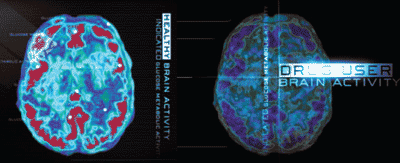YouTube: Site-Rite Instructional Video
-
Printer Friendly|#| Trackback
The AHRQ published Making Health Care Safer: A Critical Analysis of Patient Safety Practices in 2001. Chapter 21 deals with Ultrasound Guidance of Central Vein Catheterization. I thought I'd include a link to a YouTube video that shows how this device is used:
Although the device has advance considerably since then (see below), the images it provides are still pretty much the same.
I will often use the device to locate and mark an internal jugular vein before draping the patient as I find the use of the needle guide extremely cumbersome.
[Site-Rite]
NIDA: Drugs, Brains, and Behavior - The Science of Addiction
-
Printer Friendly|#| Trackback
The National Institute on Drug Abuse just published a booklet intended to help patients understand drug addiction titled The Science of Addiction.
"As a result of scientific research, we know that addiction is a disease that affects both brain and behavior. We have identified many of the biological and environmental factors and are beginning to search for the genetic variations that contribute to the development and progression of the disease. Scientists use this knowledge to develop effective prevention and treatment approaches that reduce the toll drug abuse takes on individuals, families, and communities."

Epocrates Online Free
-
Printer Friendly|#| Trackback
A reminder from The Palmdoc Chronicles that Epocrates Online Free is online and, well, free.
MMWR Available Via Really Simple Syndication (RSS) Feeds
-
Printer Friendly|#| Trackback
"MMWR now offers RSS feeds, a free, automated method to receive all MMWR publications. Through RSS, new reports and publications are fed to your desktop or browser-based news reader when they are posted online. Headlines are presented in the RSS feeds, with links to the full reports and publications on the MMWR website. RSS feeds to MMWR publications are available at http://www.cdc.gov/mmwr/rss/rss.html"
[CDC]
EFF: Legal Guide for Bloggers
-
Printer Friendly|#| Trackback
Electronic Frontier Foundation: Legal Guide for Bloggers
"The goal here is to give you a basic roadmap to the legal issues you may confront as a blogger, to let you know you have rights, and to encourage you to blog freely with the knowledge that your legitimate speech is protected."
[Via O'Reilly Radar]

CDC: Disinfectants and Their Properties
-
Printer Friendly|#| Trackback
The CDC published (as an appendix to another report) a guide on which disinfectant work for what organisms:
"All surfaces should be cleaned thoroughly before disinfection. For basic disinfection, a 1:100 dilution of household bleach (i.e., 2.5 tablespoons/gallon) or a 1:1,000 dilution of quaternary ammonium compounds (e.g., Roccal-D® or Zephiran®) may be used. This appendix includes instructions for disinfection when a particular organism has been identified. All compounds require a contact time of >10 minutes."
Health, United States, 2004 with Special Feature on Drugs
-
Printer Friendly|#| Trackback
Health, United States, 2004 with Special Feature on Drugs
""Health, United States, 2004, is the 28th annual report on the health status of the Nation and is submitted by the Secretary of the Department of Health and Human Services to the President and Congress. It assesses the Nation’s health by presenting trends and current information on selected determinants and measures of health status in a chartbook followed by 153 trend tables organized around four major subject areas: health status and determinants, health care utilization, health care resources, and health care expenditures.""
Guidelines: Coronary Artery Bypass Grafting
-
Printer Friendly|#| Trackback
Guidelines updated for Coronary Artery Bypass Grafting (CABG):
" "Key Points
- Off-pump CABG, which avoids aortic cannulation and cardiopulmonary bypass, is now available in many hospitals. However, three randomized trials comparing neurologic outcomes after off-pump and on-pump CABG provide insufficient evidence to warrant the conclusion that the off-pump procedure is better for limiting neurologic complications.
- The authors note that long-term data from trials of angioplasty versus CABG (most notably the BARI trial) continue to show significant advantages with CABG for preventing death and repeat revascularization in diabetes patients.
- Since 1999, both stent use and left internal mammary-artery grafting have become more common. The most recent randomized trial data show that rates of death, MI, and stroke remain similar for CABG recipients compared with stent recipients. The authors also mention that CABG's advantage over stenting for preventing repeat revascularization has narrowed, but remains significant.
- In a class I recommendation, the authors write that aspirin is "the drug of choice" for prophylaxis against early saphenous-vein graft closure and should be continued indefinitely.
- There is a new class I recommendation for statin therapy in all CABG patients, unless contraindicated.
- Hormone replacement therapy should no longer be initiated in women after CABG.
- The new guidelines emphasize the importance of understanding how newer antithrombotic and antiplatelet therapies affect bleeding risk in acute coronary syndrome patients who undergo CABG. For example, the authors have made a class I recommendation that clopidogrel be withheld for 5 days before CABG, if clinical circumstances permit.
- Several new sections have been added, including those about off-pump techniques, robotic coronary bypass, and the value of clinical guidelines and pathways for guiding postoperative care and improving outcomes." "
[Via Medscape Headlines]
What Is the Rhythm?
-
Printer Friendly|#| Trackback
Medscape: What Is the Rhythm? Part of their ECG of the week series.

